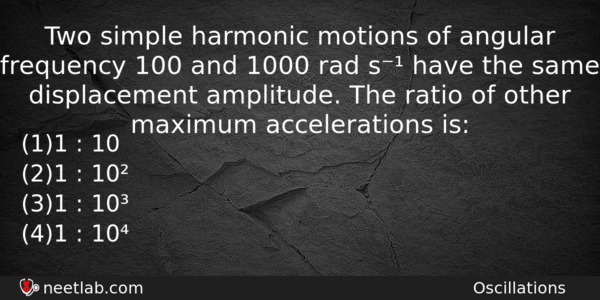| ⇦ | 
| ⇨ |
Two simple harmonic motions of angular frequency 100 and 1000 rad s⁻¹ have the same displacement amplitude. The ratio of other maximum accelerations is:
Options
(a) 1 : 10
(b) 1 : 10²
(c) 1 : 10³
(d) 1 : 10⁴
Correct Answer:
1 : 10²
Explanation:
Maximum acceleration of a particle in the simple harmonic motion is directly proportional to the square of angular frequency i.e., a(max)= – w ² A
As A remains same, we can say
a₁ / a₂ = w₁² / w₂² = (100)² / (1000)² = 1 / 100
⇒ a₁ : a₂ = 1 : 10²
Related Questions: - When an object is placed 40cm from a diverging lens, its virtual image is formed 20 cm
- Source S₁ is producing, 10¹⁵ photons per second of wavelength 5000Å
- The distance of the closest approach of an alpha particle fired at a nucleus
- A nucleus ᴢXᴬ emits an α- particle with velocity v. The recoil speed of the daughter
- A body of mass m=3.513 kg is moving along the x-axis with a speed of 5 m/s
Topics: Oscillations
(58)
Subject: Physics
(2479)
Important MCQs Based on Medical Entrance Examinations To Improve Your NEET Score
- When an object is placed 40cm from a diverging lens, its virtual image is formed 20 cm
- Source S₁ is producing, 10¹⁵ photons per second of wavelength 5000Å
- The distance of the closest approach of an alpha particle fired at a nucleus
- A nucleus ᴢXᴬ emits an α- particle with velocity v. The recoil speed of the daughter
- A body of mass m=3.513 kg is moving along the x-axis with a speed of 5 m/s
Topics: Oscillations (58)
Subject: Physics (2479)
Important MCQs Based on Medical Entrance Examinations To Improve Your NEET Score
18000+ students are using NEETLab to improve their score. What about you?
Solve Previous Year MCQs, Mock Tests, Topicwise Practice Tests, Identify Weak Topics, Formula Flash cards and much more is available in NEETLab Android App to improve your NEET score.
Share this page with your friends

Leave a Reply